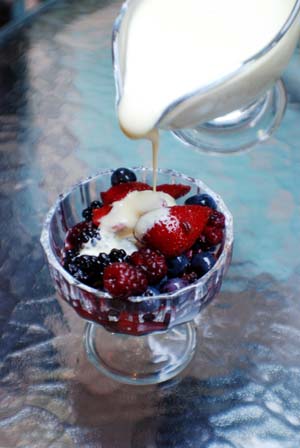
Master this classic custard sauce, and you’ll never see dessert the same way again! Try it over berries, bread pudding, pound cake—or even as a decadent “dunk” for simple cookies.

| 1 | vanilla bean, split | |
| 2 | cups | half-and-half |
| 6 | egg yolks | |
| 1/3 | cup | sugar |
Set a wire mesh strainer over a spacious, heat-resistant bowl, then set that bowl in a larger bowl half-filled with ice.
- Place the half-and-half in a heavy-bottomed pan set over medium heat. Add the split vanilla bean and bring to a simmer.
- Remove the vanilla bean halves and scrape the microscopic seeds into the mixture. Reserve the bean pods for another use.*
- Bring the half-and-half back up to a simmer, watching closely to ensure that it doesn’t boil over.
- Whisk the egg yolks and sugar together in a spacious, heat-tolerant bowl until the sugar dissolves and the mixture is pale yellow.
- Temper the yolks by slowly adding one cup of the hot half-and-half mixture while whisking vigorously.
- Reduce the heat to medium-low and whisk the tempered yolks into the saucepan, creating custard. Stir constantly until the custard thickens slightly and coats the back of a wooden spoon. Crème Anglaise should be slightly thicker than heavy cream. It is important to stop cooking as soon as you reach the desired consistency.
- Immediately strain the mixture into the clean bowl set over ice.
- Cool to room temperature, then refrigerate until ready to serve.
Note: Crème Anglaise can be tricky, and may curdle if you don’t work swiftly enough at the end of the cooking process. If the cooled sauce isn’t perfectly smooth, don’t panic; just pass it through a fine strainer again.
*Rinsed and thoroughly dried, the pods are perfect for making vanilla sugar. Just fill a jar with sugar, place the pod deep into the center, and secure the lid. Let the flavor develop for several weeks then lift the lid and smell the incredible fragrance. Vanilla sugar is wonderful in custards, cookies and cakes—and as a treat in your tea or coffee.


